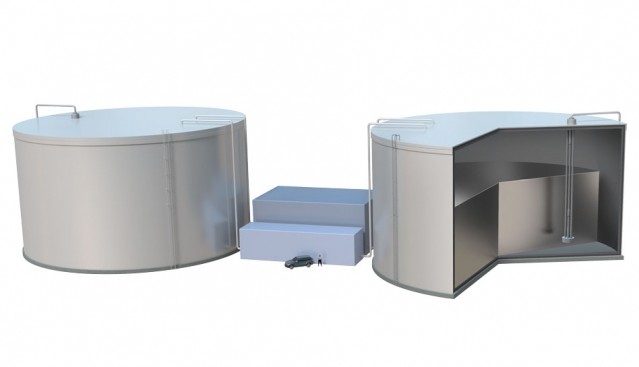Molten silicon stores excess grid energy
December 12, 2018
on
on

White hot, liquid silicon could prove to be an economic way of storing intermittent grid power. Power generated by photovoltaic cells and wind turbines is intermittent; any excess can be stored in large battery installations and released to the grid as needed. According to a study produced at MIT it could be much cheaper to store the energy in the form of incandescent molten silicon rather than lithium-ion batteries. The study suggests this method would be half as expensive as hydro pump storage, the cheapest form of storage to date.
Silicon has the advantage that at high temperatures it is not as corrosive as metal salts. The silicon would be stored in liquid form at 2,000 ° C in a thermally insulated graphite tank. Hoses with heating elements connect the base tank to a second energy storage tank, in which the liquid silicon is at 2,400 ° C.
By heating and simultaneously pumping the silicon from the base tank into the storage tank, excess energy is taken up from the mains supply and stored. When energy is needed again, silicon from the store is pumped back into the base tank. The trick here is that the connecting pipes emit high-energy light due to its high temperature. This light can then be converted back into electrical energy using special high-temperature photovoltaic modules.
The process is called TEGS-MPV (Thermal Energy Grid Storage Multi-junction Photovoltaics). When emitting light, the connecting tubes serve as an extremely intense light source. Despite its incandescent contents, thermal insulation ensures the outer walls of the storage tanks remain at room temperature.
It is reasonable to assume that molten silicon would react very quickly with the graphite of the vessel walls to create silicon carbide and thus have a very corrosive effect. According to the researchers, testing with silicon at 2,150 ° C for one hour showed that a layer of silicon carbide does indeed form at the interface but acts to as a protective film to prevent further corrosion of the graphite tanks. The production of such large tanks in one piece is impractical. Therefore, it has been proposed to secure the components with carbon fibre fixtures and seal the spaces with a kind of flexible graphite. Last year, the researchers developed a pump suitable for use with liquid silicon. It has since been registered in the Guinness Book of Records as the world’s highest temperature pump.
According to MIT, a single energy buffer store would be sufficient for a city with 100,000 homes. The energy storage system could be installed in almost any location without the need to construct dams or other features.
The research results were published in the journal Energy & Environmental Science.
Silicon has the advantage that at high temperatures it is not as corrosive as metal salts. The silicon would be stored in liquid form at 2,000 ° C in a thermally insulated graphite tank. Hoses with heating elements connect the base tank to a second energy storage tank, in which the liquid silicon is at 2,400 ° C.
By heating and simultaneously pumping the silicon from the base tank into the storage tank, excess energy is taken up from the mains supply and stored. When energy is needed again, silicon from the store is pumped back into the base tank. The trick here is that the connecting pipes emit high-energy light due to its high temperature. This light can then be converted back into electrical energy using special high-temperature photovoltaic modules.
The process is called TEGS-MPV (Thermal Energy Grid Storage Multi-junction Photovoltaics). When emitting light, the connecting tubes serve as an extremely intense light source. Despite its incandescent contents, thermal insulation ensures the outer walls of the storage tanks remain at room temperature.
It is reasonable to assume that molten silicon would react very quickly with the graphite of the vessel walls to create silicon carbide and thus have a very corrosive effect. According to the researchers, testing with silicon at 2,150 ° C for one hour showed that a layer of silicon carbide does indeed form at the interface but acts to as a protective film to prevent further corrosion of the graphite tanks. The production of such large tanks in one piece is impractical. Therefore, it has been proposed to secure the components with carbon fibre fixtures and seal the spaces with a kind of flexible graphite. Last year, the researchers developed a pump suitable for use with liquid silicon. It has since been registered in the Guinness Book of Records as the world’s highest temperature pump.
According to MIT, a single energy buffer store would be sufficient for a city with 100,000 homes. The energy storage system could be installed in almost any location without the need to construct dams or other features.
The research results were published in the journal Energy & Environmental Science.
Source: MIT News
Read full article
Hide full article


Discussion (1 comment)